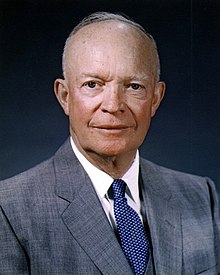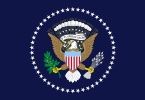Dwight D. Eisenhower
Dwight D. Eisenhower | |
|---|---|
 Official portrait, 1959 | |
| 34th President of the United States | |
| In office January 20, 1953 – January 20, 1961 | |
| Vice President | Richard Nixon |
| Preceded by | Harry S. Truman |
| Succeeded by | John F. Kennedy |
| 1st Supreme Allied Commander Europe | |
| In office April 2, 1951 – May 30, 1952 | |
| President | Harry S. Truman |
| Deputy | Arthur Tedder |
| Preceded by | Position established |
| Succeeded by | Matthew Ridgway |
| 16th Chief of Staff of the Army | |
| In office November 19, 1945 – February 6, 1948 | |
| President | Harry S. Truman |
| Deputy | J. Lawton Collins |
| Preceded by | George Marshall |
| Succeeded by | Omar Bradley |
| Military Governor of the U.S. Occupation Zone in Germany | |
| In office May 8, 1945 – November 10, 1945 | |
| President | Harry S. Truman |
| Preceded by | Position established |
| Succeeded by | George S. Patton (acting) |
| 13th President of Columbia University | |
| In office June 7, 1948 – January 19, 1953 | |
| Preceded by | Frank D. Fackenthal (acting) |
| Succeeded by | Grayson L. Kirk |
| Personal details | |
| Born | Dwight David Eisenhower October 14, 1890 Denison, Texas, U.S. |
| Died | March 28, 1969 (aged 78) Washington, D.C., U.S. |
| Resting place | Dwight D. Eisenhower Presidential Library and Museum |
| Political party | Republican |
| Height | 1.78 m (5 ft 10 in) |
| Spouse(s) | Mamie Doud (m. 1916) |
| Relations |
|
| Children |
|
| Parents |
|
| Education | United States Military Academy (BS) |
| Signature | |
| Military service | |
| Branch/service | |
| Years of service |
|
| Rank | |
| Battles/wars | |
| Awards | |
Dwight David "Ike" Eisenhower(/ˈaɪzənhaʊ.ər/ EYE-zən-how-ər (October 14, 1890 – March 28, 1969) was the 34th president of the United States, from 1953 to 1961. He was known across the world for his help leading the Allied invasions in World War II.
Early life[change | change source]
Dwight David Eisenhower was born on October 14, 1890, at 609 S. Lamar Avenue in Denison, Texas. He was the third of seven sons.[2] His mother originally named him David Dwight, but she switched two names after his birth so that there wouldn't be two Davids in the family.[3]
In 1892, the family moved to Abilene, Kansas, which Eisenhower considered his hometown.[4] Dwight became very interested in exploring the outdoors. He learned about hunting and fishing, cooking, and card playing from a man named Bob Davis who camped on the Smoky Hill River.[5][6][7]
Eisenhower went to Abilene High School. He graduated with the class of 1909.[8] He and brother Edgar both wanted to go to college, but they did not have enough money. They decided to take different years at college while the other worked to earn money to pay the tuitions.[9]
Edgar took the first turn at school, and Dwight was working a job as a night supervisor at the Belle Springs Creamery.[10] When Edgar asked for a second year, Dwight accepted and worked for a second year. At that time, a friend named "Swede" Hazlett was applying to the Naval Academy. He wanted Dwight to apply to the school, since there was no tuition. Eisenhower asked for consideration for either Annapolis or West Point with his U.S. Senator, Joseph L. Bristow. Though Eisenhower was one of the winners of the entrance-exam competition, he was too old for the Naval Academy.[11] He then accepted an appointment to West Point in 1911.[11]
At West point, Eisenhower liked the traditions and the sports. In sports, Eisenhower later said that "not making the baseball team at West Point was one of the greatest disappointments of my life, maybe my greatest".[12] He joined the varsity football team[13][14] and was a starter as running back and linebacker in 1912. He tackled the legendary Jim Thorpe of the Carlisle Indians.[15] Eisenhower got a torn knee while being tackled in the next game, which was the last he played; he re-injured his knee on horseback and in the boxing ring,[4][5][16] so he turned to fencing and gymnastics.[4]
Eisenhower later served as junior varsity football coach and cheerleader. He graduated in the middle of the class of 1915.[17] That class became known as "the class the stars fell on", because 59 members became general officers.
Military career[change | change source]
Eisenhower was born into a family which did not have much money. He joined the United States Military Academy at West Point as a cadet in 1911, and as an officer served in many different places including the Panama Canal Zone, Washington, D.C. and the Philippines. During World War II, he was a general. He directed the invasion of Morocco and Algeria during the North African Campaign. He became a 5-star general and was the Supreme Allied Commander for Operation Overlord (an attack on Germany which was one of the most important battles of the war).
After World War II ended, he was considered a war hero. In the 1952 U.S. presidential election, the American public begged Eisenhower to run for president. Eisenhower (whose political views were unknown at the time) joined the Republican Party. He chose Richard Nixon as his vice-presidential candidate and won the election by beating Adlai Stevenson II.
Presidency, (1953–1961)[change | change source]
He served two terms from 1953 to 1961. Eisenhower was the first President of the United States to be president of all 50 states.[18]
During the beginning of his first term, he oversaw a ceasefire (which stopped the fighting) during the Korean War. He created NASA (the United States space program) which began a space race against the Soviet Union. Eisenhower believed that the United States should not try to fight wars overseas, but instead that United States should make more nuclear weapons so it could have an advantage in the Cold War. The United States was able to keep the Soviet Union in check without spending a lot of money. For this reason, the U.S. government had balanced budgets during his presidency and did not have to borrow money.
He intimidated the Soviet Union by making them believe that the United States would respond to any act of aggression with the use of nuclear weapons. That policy is called brinkmanship, new look, and massive retaliation. He also authorized planes to spy on the Soviet Union, but when a U.S. spy plane accidentally crashed into the Soviet Union near the end of Eisenhower's term, it hurt relations between the United States and the Soviet Union.
McCarthyism (when Senator Joseph McCarthy was accusing hundreds of people of being communist spies without evidence) was also an issue during his presidency. Eisenhower disliked Joseph McCarthy and tried to bring him down behind the scenes, but Eisenhower did not like to make enemies, so he did not talk about McCarthy much.
Domestically (in the country), the economy was doing very well and the nation was prosperous. Eisenhower supervised the creation of the interstate highway system and created the Department of Health, Education, and Welfare. Eisenhower was a moderate conservative (near the center of the political spectrum). He wanted to continue some New Deal programs such as Social Security, but at the same time, he wanted the government to be limited. At first, many criticized him for not doing enough to give civil rights to African Americans, but later during his presidency, he signed two civil rights acts and sent federal troops to Little Rock, Arkansas to make sure schools were desegregated.
Legacy[change | change source]
When Eisenhower's presidency ended he was not very popular with scholars. Over time his reputation slowly improved and historians now generally consider him to be a good president. he died of heart failure in Washington D. C at age 78
In September 2020, a presidential memorial was dedicated in Washington, D.C. honoring Eisenhower.[19]
References[change | change source]
- ↑ "The Eisenhower Presidential Library and Museum Homepage". Eisenhower.utexas.edu. Archived from the original on October 23, 2013. Retrieved September 5, 2012.
- ↑ D'Este, Carlo (2003). Eisenhower: A Soldier's Life. New York: Macmillan. pp. 21–22. ISBN 0805056874. Archived from the original on February 15, 2017. Retrieved September 13, 2016.
- ↑ Ambrose 1983, p. 18
- ↑ 4.0 4.1 4.2 Barnett, Lincoln (November 9, 1942). "General "Ike" Eisenhower". Life. p. 112. Retrieved May 31, 2011.
- ↑ 5.0 5.1 Eisenhower, Dwight D. (1967). At Ease: Stories I Tell to Friends, Garden City, New York, Doubleday & Company, Inc.
- ↑ D'Este, Carlo (2002). Eisenhower: A Soldier's Life, p. 25.
- ↑ "Getting on the Right TRRACC" (PDF). Lesson Plans: The Molding of a Leader. Eisenhower National Historic Site. Archived (PDF) from the original on March 26, 2014. Retrieved April 27, 2013.
... Ike spent his weekends at Davis's camp on the Smoky Hill River.
- ↑ "Public School Products". Time. September 14, 1959.
- ↑ Ambrose 1983, p. 37
- ↑ "Eisenhower: Soldier of Peace". Time. April 4, 1969. Archived from the original on May 24, 2008. Retrieved May 23, 2008.
- ↑ 11.0 11.1 "Biography: Dwight David Eisenhower". Eisenhower Foundation. Archived from the original on May 23, 2008. Retrieved May 23, 2008.
- ↑ "President Dwight D. Eisenhower Baseball Related Quotations". Baseball Almanac. Archived from the original on May 21, 2008. Retrieved May 23, 2008.
- ↑ "Eisenhower BOQ 1915". Fort Sam Houston. Archived from the original on July 17, 2007. Retrieved August 23, 2012.
- ↑ "Lt Eisenhower and Football Team". Fort Sam Houston. Archived from the original on July 17, 2007. Retrieved August 23, 2012.
- ↑ Botelho, Greg (July 15, 1912). "Roller-coaster life of Indian icon, sports' first star". CNN. Archived from the original on November 14, 2007. Retrieved May 23, 2008.
- ↑ "Ike and the Team". Dwight D. Eisenhower Memorial. Archived from the original on July 25, 2008. Retrieved May 23, 2008.
- ↑ "Dwight David Eisenhower". Internet Public Library. Archived from the original on May 11, 2008. Retrieved May 23, 2008.
- ↑ "Dwight D. Eisenhower". President of the.us. Retrieved November 4, 2013.
- ↑ Horan, Tim (May 8, 2020). "Eisenhower Memorial in D.C. is complete. Coronavirus delays dedication to September". The Wichita Eagle. Retrieved May 8, 2020.
Other websites[change | change source]
| Definitions from Wiktionary | |
| Media from Commons | |
| News stories from Wikinews | |
| Quotations from Wikiquote | |
| Source texts from Wikisource | |
| Textbooks from Wikibooks | |
| Learning resources from Wikiversity | |
- Presidents of the United States
- 1890 births
- 1969 deaths
- American military personnel of World War I
- American military personnel of World War II
- Deaths from congestive heart failure
- Dwight D. Eisenhower
- Honorary Knights Grand Cross of the Order of the Bath
- Military-industrial complex
- Order of Merit
- Politicians from Texas
- Recipients of the Nishan-e-Pakistan
- Recipients of the Order of the Aztec Eagle
- Recipients of the Order pro merito Melitensi
- Time People of the Year
- Republican Party (United States) politicians
- 20th-century American politicians
- Kansas Republicans
- Anti-communists
- People from Denison, Texas
- Military people from Kansas


